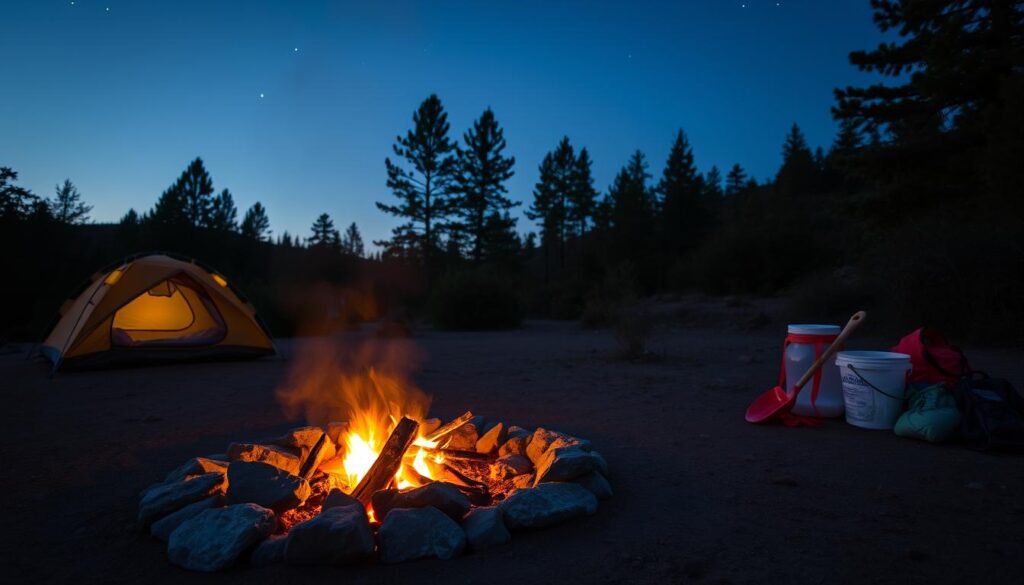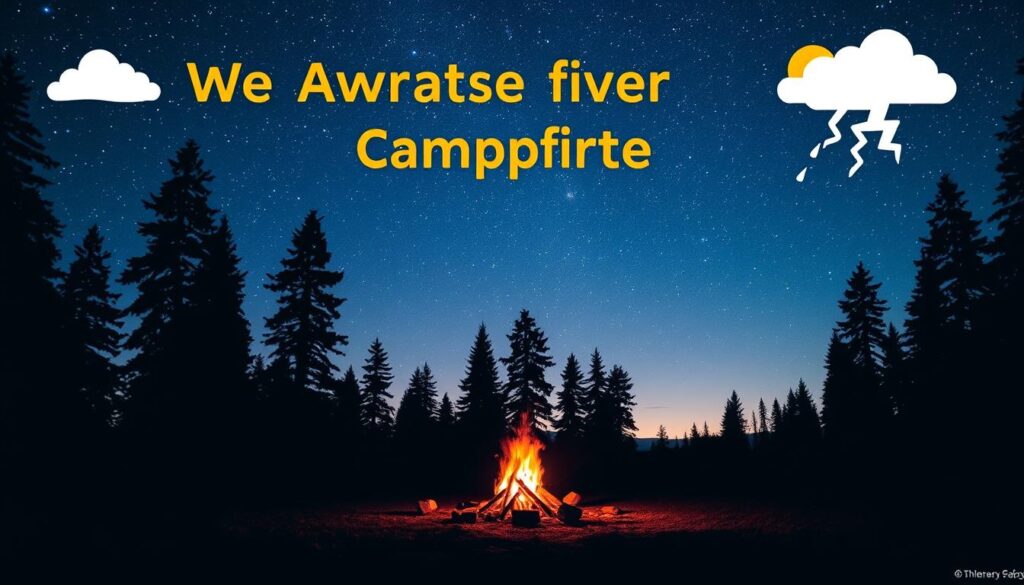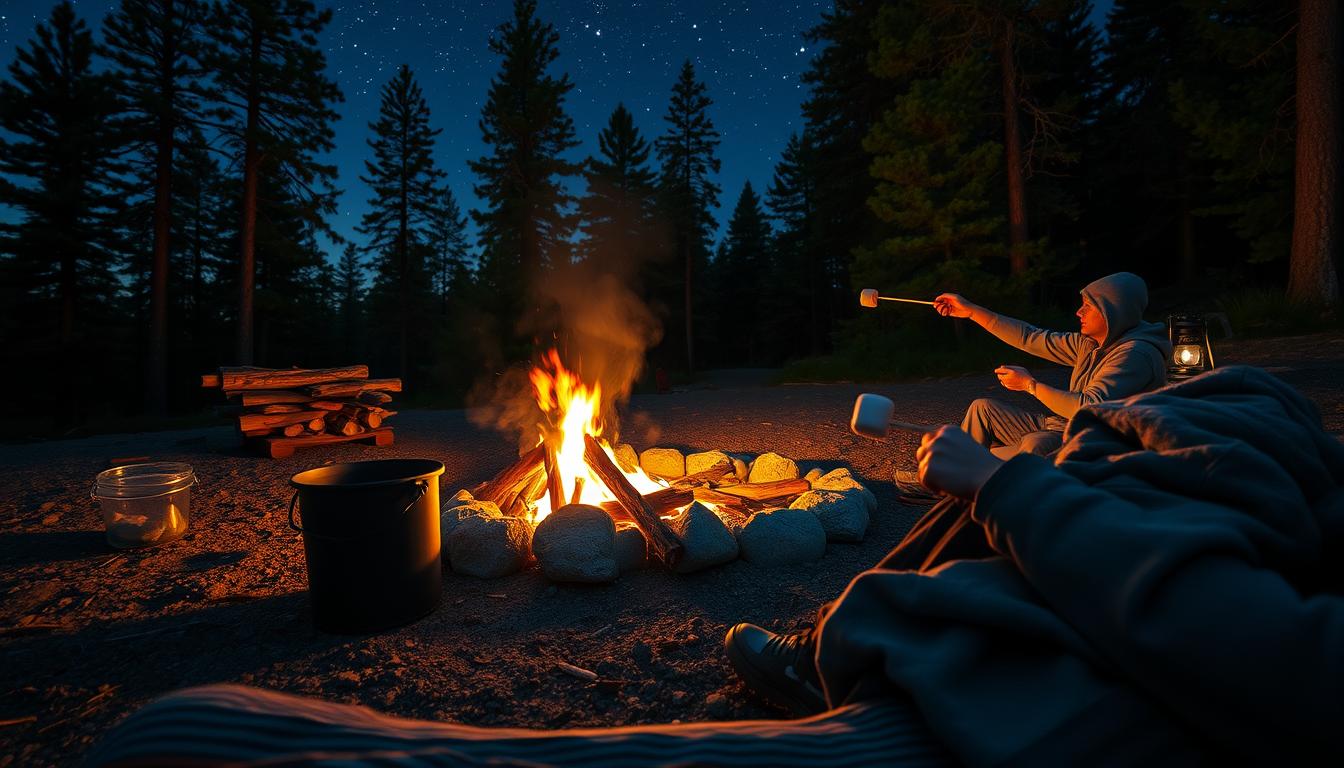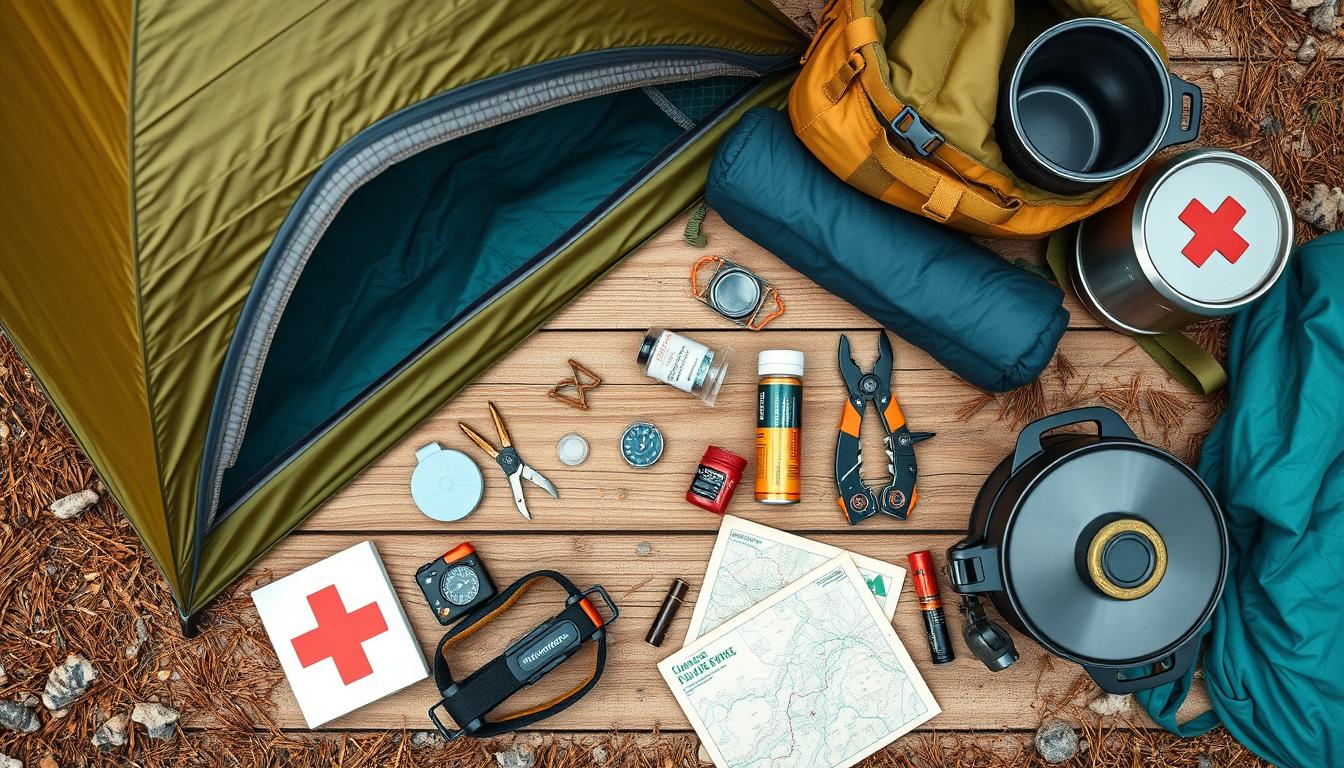As an outdoor enthusiast, I love gathering around a campfire. We share stories and enjoy nature. But, campfire safety is key to keep these moments safe and fun.
Following important campfire safety tips helps me avoid accidents. It keeps me and my friends safe, and protects nature too. The right campfire preparation is vital to avoid wildfires and keep everyone safe.
In this guide, I’ll share tips for safe campfires. These strategies make our outdoor adventures better and safer.
Key Takeaways
- Understanding campfire safety tips is essential for every camper.
- Proper campfire preparation can prevent accidents.
- Safe campfires contribute to enjoyable camping experiences.
- Recognizing the risks of outdoor fire safety is crucial.
- Being proactive ensures a secure environment during camping trips.
Understanding the Importance of Campfire Safety
Campfires can make our time in nature better, but they also pose dangers. I think a lot about keeping campfires safe, especially with the rise in wildfires. Over 80,000 wildfires in the U.S. show how crucial campfire safety is to avoid these disasters.
Not managing campfires well can lead to many camping fire risks. A small spark can quickly grow into a big fire, especially in dry conditions or with strong winds. Knowing how fires work and managing them safely lets me enjoy the fire while protecting nature.
Wildfires are just one danger from campfires. They can also hurt people, damage property, and harm wildlife. Knowing these risks makes it clear we must always put safety first when starting a fire. It’s everyone’s job to learn and teach others about safe campfire practices.
| Fire Danger Level | Description | Recommended Actions |
|---|---|---|
| Low | Good conditions for campfires; minimal risk of wildfires. | Monitor fire; keep fire pit contained. |
| Moderate | Increased risk; fire may spread under certain conditions. | Limit campfire size; keep a water source nearby. |
| High | Significant fire hazards; risk of wildfires elevated. | Consider alternatives to campfires; use propane stoves. |
| Very High | Severe risk; campfires may be prohibited. | Abide by regulations; inform others about dangers. |
With the right precautions and knowledge, camping can be fun and safe. Focusing on campfire safety helps keep everyone safe. This way, we can all enjoy nature’s beauty without worrying about fires.
Choosing the Right Location for Your Campfire
Finding the right spot for your campfire is key for safety and fun outdoors. A good spot adds to the campsite’s beauty and lowers fire risks. Paying attention to wind direction and nearby trees and brush is important for campfire safety.
Consider Wind Direction
Understanding wind direction is crucial when picking a campfire spot. Wind can spread sparks and embers, posing dangers. It’s best to place the fire where the wind carries sparks away from flammable things. This makes the campsite safer for everyone.
Look for Nearby Trees and Brush
Nature’s beauty is great, but watch out for trees and brush. They can catch fire easily if they touch flames or hot embers. I aim to pick spots at least 15 feet away from these dangers. This keeps nature safe and makes camping better.
| Factors to Consider | Tips |
|---|---|
| Wind Direction | Position your campfire so that the wind blows away from flammable materials. |
| Proximity to Trees | Avoid placing the fire near dry trees or dense brush. |
| Distance from Tent | Keep the fire at least 15 feet away from your tent and other camping gear. |
| Ground Surface | Choose a flat and stable surface to minimize any accidental tipping of items. |
Gathering Necessary Campfire Equipment
Having the right campfire equipment is key for a safe and fun camping trip. There are many fire pits to choose from, each with its own benefits. Knowing what campfire gear to pack can help you build and keep a fire efficiently.
Types of Fire Pits
When picking a fire pit, think about what fits your camping style. Here are some common types:
- Portable Fire Pits – Lightweight and easy to carry, great for moving around.
- Stone Fire Circles – A solid choice for those with a fixed camping spot.
- Propane Fire Pits – Easy to set up and control, perfect for quick use.
- Fire Bowls – Stylish and good for heat, adds to the look of your campsite.
Essential Gear for Building a Campfire
Having the right tools for building a fire is important. Here’s the basic campfire gear I always carry:
- Matches or Lighters – For starting the fire fast and safely.
- Fire Starters – Essential for starting a flame, especially in wet conditions.
- Kindling – Small twigs and sticks to help the fire grow.
- Firewood – A mix of hardwood and softwood for steady burning.
- Shovel or Trowel – Useful for moving ashes or digging fire pits.
Having the right campfire gear makes your fire safer and more enjoyable. Always follow fire safety rules to ensure a safe and fun time around the campfire.
10 Campfire Safety Tips Every Camper Should Know
Knowing the basics of campfire safety is key for a fun outdoor trip. Here are the top tips for campfire safety that every camper should remember:
- Always choose an appropriate location for your campfire. Look for clear ground, away from overhanging branches, and check if campfire guidelines for the area permit fires.
- Use a designated fire pit if available. This helps contain the fire and aligns with fire safety practices.
- Keep your campfire small and manageable. A large fire can be unpredictable and challenging to control.
- Supervise the campfire at all times. Never leave it unattended, as a moment of inattention can lead to dangerous situations.
- Use dry, seasoned wood. Avoid burning green wood or garbage, which can produce harmful smoke and embers.
- Extinguish the fire when done. Use water to fully douse the flames and keep stirring the ashes until they are cool to the touch.
- Establish boundaries for children and pets around the campfire. Clear communication about safety reduces risks associated with fire proximity.
- Check the local fire regulations and warnings. These campfire guidelines can change based on weather conditions.
- Have a bucket of water or sand nearby while the campfire is lit. This prepares you to handle any flare-ups immediately.
- Always dispose of ashes responsibly. Cool ashes should be placed in a metal container to prevent accidental fires.

How to Safely Build a Campfire
Going on a camping trip means learning how to build a campfire safely. Knowing how to layer your fire is key for a great campfire experience. The right way to do it keeps the fire under control and uses the right materials.
Layering Techniques for a Successful Fire
Using the right fire layering methods is crucial for a good campfire. There are two main ways to do this:
- Teepee Method: Make a cone shape with your kindling, with the biggest sticks leaning against it. This helps the fire start quickly because of good airflow.
- Log Cabin Method: Stack logs in a square shape, leaving space for air to flow. Place kindling in the middle to light the larger logs, keeping the fire burning steadily.
Choosing the Right Kindling and Fuel
Choosing the right materials for your campfire is important. For kindling, look for:
- Dry leaves
- Small twigs
- Strips of bark
For the main fuel, pick untreated logs. Avoid using treated wood or plastics because they can release harmful fumes. By choosing the right materials, I can make a cozy campfire that’s safe for everyone.
Extinguishing Your Campfire Properly
It’s crucial to put out a campfire safely. I use a few steps to make sure the fire is fully extinguished. First, I pour water over the ashes to start. It’s important to use enough water to cover the flames.
Then, I stir the ashes with a stick or shovel. This helps get rid of any remaining heat. After that, I check if the fire site is cool to the touch.
This final check is key to safe extinguishing. I remember the rule of “cold out.” If it’s not cool, I add more water and stir until it is.
These steps help prevent accidental fires. Here’s a table with effective campfire extinguishing techniques:
| Technique | Description |
|---|---|
| Water Application | Pour water over the fire to extinguish flames, ensuring sufficient amounts are used. |
| Stirring Ashes | Use a stick or shovel to stir the ashes thoroughly for better extinguishing. |
| Cold Touch Check | Ensure the site feels cool, indicating that the fire is no longer active. |
| Reapply Water | If ashes are warm, add more water and stir again until cool. |
Maintaining a Safe Distance from the Fire
Keeping a safe distance from the campfire is key for everyone’s safety, especially kids and pets. Setting clear boundaries helps avoid accidents. I use both physical barriers and clear communication to set these limits.
Setting Boundaries for Children and Pets
When we camp, I make sure kids and pets stay at least 10 feet from the fire. This keeps them safe from heat and flying sparks. I use markers like rope or cones to show safe areas. I also watch them closely to make sure they know the rules.
Understanding the Risks of Proximity
It’s important to know the dangers of being too close to the fire. Heat and sparks can travel far beyond what you see. I talk to my friends about these risks to keep everyone safe. By staying far from the fire, we all have a better camping experience.
Weather Considerations for Campfire Safety
Knowing how weather affects campfire safety is key for campers. Rain makes it hard to start and keep a fire going. It’s important to plan and stay safe based on the weather.
Campfire Safety in Rainy Conditions
Keeping a fire going in the rain needs special strategies. Using seasoned hardwood is best because it burns well. I look for dry kindling to start the fire easily.
Building a windbreak with logs or rocks helps keep the fire stable. This is crucial for safety and comfort.
When it rains, I start with a small fire and build it up slowly. Using a covered fire pit or a tarp helps keep the fire dry. These steps make camping safer and more fun.

Staying Prepared for Emergencies
Being ready for unexpected situations while camping is key. Campfire emergency preparedness means knowing fire safety and having the right tools. A fire safety kit is vital, with everything you need in case of a fire.
Creating a Fire Safety Kit
A good fire safety kit can save lives in emergencies. Here are the must-haves I always carry:
- Water bottles or a portable water container
- Fire extinguisher rated for Class A, B, and C fires
- Emergency blankets for warmth
- Flashlights with extra batteries
- First aid supplies
- Whistle to signal for help
- A small shovel for soil or removing debris
- Non-perishable snacks for energy
What to Do in Case of a Fire Incident
Dealing with fire incidents needs quick action. Here’s how I handle them:
- Stay calm and decide whether to fight the fire or get out.
- Warn others and keep a safe distance from the fire.
- If fighting the fire, aim at the base with the extinguisher. Use water only if it’s safe.
- If the fire gets too big, get away from it.
- Call emergency services right away, giving them the fire’s location and dangers.
Being prepared and informed is essential for campfire safety. With a good fire safety kit and knowing what to do in a fire, camping can be safer for everyone.
Educating Your Camping Group on Fire Safety
Teaching fire safety to my camping group is key. I start with a safety briefing before we camp. This is where I share important fire safety rules everyone must follow.
This briefing helps create a culture of safety and responsibility. It’s important to talk about fire risks and how to manage them. This way, everyone knows their part in keeping the camp safe.
During the briefing, I explain who does what with the campfire. Knowing your role can prevent accidents. I suggest dividing tasks like gathering firewood, cooking, and watching the fire.
This helps keep the campfire safe and makes our trip better. It’s a way to make sure everyone is on the same page.
I also like to show how to build, keep, and put out campfires. This hands-on learning helps campers understand fire risks better. It teaches them to make smart choices while outdoors.
Having resources and guidelines available helps them learn more about fire safety. This education is crucial for a safe and fun camping trip.
For more tips on fire safety, check out essential guidelines. Following these tips makes our camping trips safer and more enjoyable for everyone.
Environmental Considerations: Leave No Trace
When I enjoy the outdoors, I must think about how campfires affect the environment. By following the leave no trace principles, I can enjoy nature without harming it. I will talk about how campfires impact the environment and how to use fire responsibly.
Understanding the Impact of Campfires
Campfires can harm the environment a lot. They can damage soil, plants, and homes of animals. Wood fires also release ash and pollutants that can pollute water.
I understand how important it is to protect our ecosystems. I want to keep natural places beautiful for everyone to enjoy in the future.
Practicing Responsible Fire Management
To reduce my impact, I follow some rules for fire use. I use fire pits, keep fires small, and make sure they are fully extinguished before leaving. By doing this, I help keep nature beautiful.
Collecting leftover materials and following local rules are key. This way, I help protect the places I love to visit.
Conclusion
Following the 10 campfire safety tips is crucial. A small mistake can cause big problems, not just for us but for nature too. This summary shows that safe camping makes our outdoor adventures better and safer.
Remember, keeping nature safe is everyone’s job. We all need to follow safe camping rules to protect our beautiful surroundings. By doing so, we can enjoy campfires without harming the environment.
Being prepared, educated, and careful while camping keeps everyone safe and our nature spots intact. When we focus on safety and care for the environment, we make camping better for everyone now and in the future.




Leave a Reply